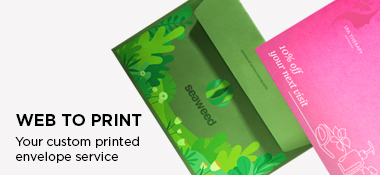SEALING METHODS
There are a variety of envelope sealing methods which can be used for different applications. Below we share insight into most common sealing types…
Gummed Envelopes

A water soluble gum is the most common sealing method, and one that is always used for mailing envelopes.
This requires moistening the layer of adhesive along the envelope flap and pressing it shut.
The gum used on these envelopes is water soluble and typically made from a blend of synthetic resin and dextrin, therefore it is biodegradable.
Gummed envelopes are the only envelopes that are suitable for automatic machine inserting, where the sealing can be performed automatically by the mailing machine.
Providing these envelopes are stored in the correct conditions, they should last for a number of years.
Self Seal Envelopes

Self seal envelopes feature a strip of latex on each flap which, when pressed together, form an instant bond.
This method of sealing may also be referred to as Dri-Seal, Press-Seal or Fast-Seal.
The latex on these is derived from rubber and ammonium substrate, and can therefore be classed as a natural product.
This normally has a guaranteed shelf life of only twelve months from date of manufacture, however, in the correct conditions this may extend.
Self seal envelopes must be stored in a equilibrium temperature, hence the reason we have carefully controlled heating in our warehouse in the winter and cooling in the summer.
Peel and Seal Envelopes (or Powerseal)

Peel & seal sealing is one of the most secure ways to seal an envelope. The release tape is simply peeled away from the flap to reveal a strip of latex which, when pressed, forms an instant bond. There are two types of peel and seal adhesive;
Cold Melt: This, like self seal latex, has one band of adhesive which is covered by a large silicone paper strip. Envelopes with this sealing normally have a shelf life of 2 years.
Hot Melt: The most common type of peel and seal envelopes that Blake stock, this has a narrow band of adhesive of a heavier gram weight than normal peel and seal. With hot melt, we can guarantee up to 5 years shelf life. Due to its sealing properties, hot melt peel and seal acts as a tamper proof security seal as it is impossible to open the envelope without tearing the flap. It can also be referred to as Super Seal, Strip Seal or Peel and Stick.




















 Black
Black Purple
Purple Blue
Blue Red
Red Green
Green Yellow
Yellow Grey
Grey White
White Pink
Pink Cream
Cream Brown
Brown Navy
Navy Violet
Violet Lime
Lime Orange
Orange





















